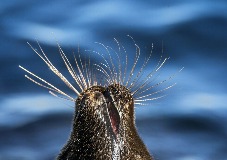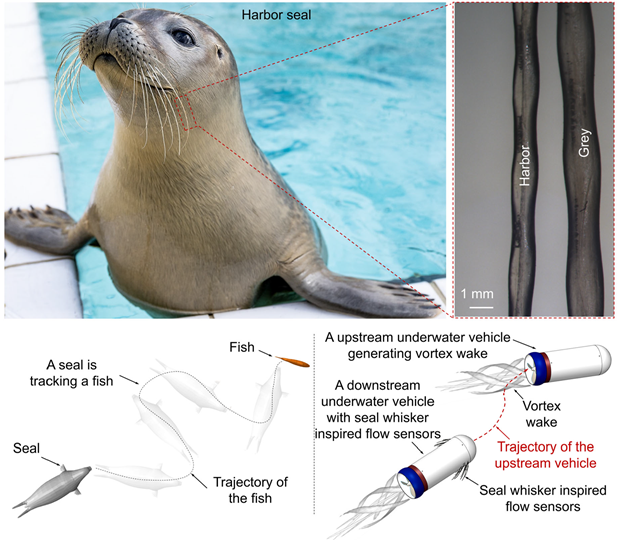Why seal whiskers are super sensors

Seals can already detect the wake of a fish at 180 metres distance. PhD student Xingwen Zheng analysed whiskers from two seal species to find out how they do it. He will defend his thesis on this subject on 19 December.
The PhD project goes back to a study published in 1998. Scientists showed that a deaf and blind seal was still able to track a swimming fish. A robot fish was used to rule out that the seal could smell its prey. Somehow, the whiskers alone are enough. The seals could even find a fish hiding behind a solid object, just from the wake leading there.
Zheng first used a laser scanner to image the whiskers of harbour seals and grey seals. This was done with the help of the Dutch Seal Rehabilitation and Research Centre Pieterburen. The whiskers were not plain cylinders, but had an undulating shape. The ratio between the ‘wave length’ of the undulations and the diameter appeared to be the same in the two seal species.
In a water flow, a cylinder starts to vibrate because of the turbulence that is produced behind it. Zheng observed that an undulating whisker hardly vibrated at all. He confirmed this both with flow experiments with artificial objects and with numerical simulations with real seal whiskers. He also placed a whisker behind a cylinder in a water flow system. In this experiment, the whisker did vibrate.
Zheng’s conclusion is that whiskers are not vibrating under normal circumstances. He confirmed this with observations that show how, at normal swimming speed, the seal whiskers do not vibrate. This means that they are sensitive to any disturbance in the water flow, like the wake of a passing fish.
Furthermore, a seal can have around 60 (grey seal) to 90 (harbor seal) whiskers, which increase in size from near the nose to near the mouth. Zheng’s experiments and simulations show that such an array of whiskers increases their sensitivity as a wake detector. All in all, Zheng has shown how whiskers in two different seal species are sensitive enough to detect the wake of a passing fish at large distances.
But his thesis is not only of interest to biologists. The whiskers are real super sensors for flow detection. This could be interesting for tracking underwater life or underwater objects like submarines. Another application could be in robotic fish technology. They might use whisker-based sensors to detect where the other robot fish are and use their wake to reduce the energy required for underwater trips. In this way, they would mimic real fish, which swim more efficiently in schools.

Zheng’s conclusion is that whiskers are not vibrating under normal circumstances. He confirmed this with observations that show how, at normal swimming speed, the seal whiskers do not vibrate. This means that they are sensitive to any disturbance in the water flow, like the wake of a passing fish.
Furthermore, a seal can have around 60 (grey seal) to 90 (harbor seal) whiskers, which increase in size from near the nose to near the mouth. Zheng’s experiments and simulations show that such an array of whiskers increases their sensitivity as a wake detector. All in all, Zheng has shown how whiskers in two different seal species are sensitive enough to detect the wake of a passing fish at large distances.
But his thesis is not only of interest to biologists. The whiskers are real super sensors for flow detection. This could be interesting for tracking underwater life or underwater objects like submarines. Another application could be in robotic fish technology. They might use whisker-based sensors to detect where the other robot fish are and use their wake to reduce the energy required for underwater trips. In this way, they would mimic real fish, which swim more efficiently in schools.
| Last modified: | 15 February 2023 4.25 p.m. |
More news
-
13 May 2024
‘The colourful cells of petals never get boring!’
Most people will enjoy colours in nature. However, the interest of evolutionary biologist Casper van der Kooi goes much further: he studies how flowers, birds, butterflies, and beetles get their colours. He also studies how these colours are used...
-
13 May 2024
Trapping molecules
In his laboratory, physicist Steven Hoekstra is building an experimental set-up made of two parts: one that produces barium fluoride molecules, and a second part that traps the molecules and brings them to an almost complete standstill so they can...
-
07 May 2024
Lecture with soon to be Honorary Doctor Gerrit Hiemstra on May 24
In celebration of his honorary doctorate, FSE has invited Hiemstra to give a lecture entitled ‘Science, let's talk about it’ on the morning of 24 May
